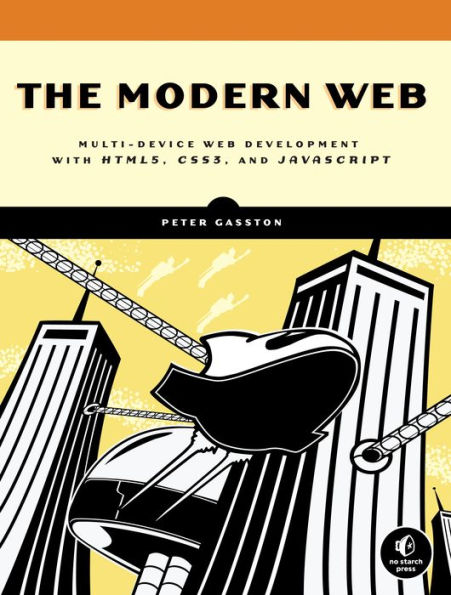
The Modern Web: Multi-Device Web Development with HTML5, CSS3, and JavaScript
264
The Modern Web: Multi-Device Web Development with HTML5, CSS3, and JavaScript
264eBook
Related collections and offers
Overview
Peter Gasston’s The Modern Web will guide you through the latest and most important tools of device-agnostic web development, including HTML5, CSS3, and JavaScript. His plain-English explanations and practical examples emphasize the techniques, principles, and practices that you’ll need to easily transcend individual browser quirks and stay relevant as these technologies are updated.
Learn how to:
–Plan your content so that it displays fluidly across multiple devices
–Design websites to interact with devices using the most up-to-date APIs, including Geolocation, Orientation, and Web Storage
–Incorporate cross-platform audio and video without using troublesome plug-ins
–Make images and graphics scalable on high-resolution devices with SVG
–Use powerful HTML5 elements to design better forms
Turn outdated websites into flexible, user-friendly ones that take full advantage of the unique capabilities of any device or browser. With the help of The Modern Web, you’ll be ready to navigate the front lines of device-independent development.

Product Details
| ISBN-13: | 9781593274887 |
|---|---|
| Publisher: | No Starch Press |
| Publication date: | 04/15/2013 |
| Sold by: | Penguin Random House Publisher Services |
| Format: | eBook |
| Pages: | 264 |
| File size: | 5 MB |
About the Author
Table of Contents
Advance Praise for The Modern Web;
Praise for Peter Gasston’s The Book of CSS3;
About the Author;
About the Technical Reviewer;
Acknowledgments;
Introduction;
The Device Landscape;
The Multi-screen World;
Context: What We Don’t Know;
What You’ll Learn;
Further Reading;
Chapter 1: The Web Platform;
1.1 A Quick Note About Terminology;
1.2 Who You Are and What You Need to Know;
1.3 Getting Our Terms Straight;
1.4 The Real HTML5;
1.5 CSS3 and Beyond;
1.6 Browser Support;
1.7 Test and Test and Test Some More;
1.8 Summary;
Further Reading;
Chapter 2: Structure and Semantics;
2.1 New Elements in HTML5;
2.2 WAI-ARIA;
2.3 The Importance of Semantic Markup;
2.4 Microformats;
2.5 RDFa;
2.6 Microdata;
2.7 Data Attributes;
2.8 Web Components: The Future of Markup?;
2.9 Summary;
Further Reading;
Chapter 3: Device-Responsive CSS;
3.1 Media Queries;
3.2 Media Queries in JavaScript;
3.3 Adaptive vs. Responsive Web Design;
3.4 Viewport-Relative Length Units;
3.5 Responsive Design and Replaced Objects;
3.6 Summary;
Further Reading;
Chapter 4: New Approaches to CSS Layouts;
4.1 Multi-columns;
4.2 Flexbox;
4.3 Grid Layout;
4.4 The Further Future;
4.5 Summary;
Further Reading;
Chapter 5: Modern JavaScript;
5.1 New in JavaScript;
5.2 JavaScript Libraries;
5.3 Polyfills and Shims;
5.4 Testing and Debugging;
5.5 Summary;
Further Reading;
Chapter 6: Device Apis;
6.1 Geolocation;
6.2 Orientation;
6.3 Fullscreen;
6.4 Vibration;
6.5 Battery Status;
6.6 Network Information;
6.7 Camera and Microphone;
6.8 Web Storage;
6.9 Drag and Drop;
6.10 Interacting with Files;
6.11 Mozilla’s Firefox OS and WebAPIs;
6.12 PhoneGap and Native Wrappers;
6.13 Summary;
Further Reading;
Chapter 7: Images and Graphics;
7.1 Comparing Vectors and Bitmaps;
7.2 Scalable Vector Graphics;
7.3 The canvas Element;
7.4 When to Choose SVG or Canvas;
7.5 Summary;
Further Reading;
Chapter 8: New Forms;
8.1 New Input Types;
8.2 New Attributes;
8.3 Datalists;
8.4 On-Screen Controls and Widgets;
8.5 Displaying Information to the User;
8.6 Client-side Form Validation;
8.7 The Constraint Validation API;
8.8 Forms and CSS;
8.9 Summary;
Further Reading;
Chapter 9: Multimedia;
9.1 The Media Elements;
9.2 Media Fragments;
9.3 The Media API;
9.4 Media Events;
9.5 Advanced Media Interaction;
9.6 Summary;
Further Reading;
Chapter 10: Web Apps;
10.1 Web Apps;
10.2 Hybrid Apps;
10.3 TV Apps;
10.4 Webinos;
10.5 Application Cache;
10.6 Summary;
Further Reading;
Chapter 11: The Future;
11.1 Web Components;
11.2 The Future of CSS;
11.3 Summary;
Further Reading;
Browser Support as of March 2013;
The Browsers in Question;
Enabling Experimental Features;
Chapter 1: The Web Platform;
Chapter 2: Structure and Semantics;
Chapter 3: Device-Responsive CSS;
Chapter 4: New Approaches to CSS Layouts;
Chapter 5: Modern JavaScript;
Chapter 6: Device APIs;
Chapter 7: Images and Graphics;
Chapter 8: New Forms;
Chapter 9: Multimedia;
Chapter 10: Web Apps;
Chapter 11: The Future;
Further Reading;
Introduction;
Chapter 1: The Web Platform;
Chapter 2: Structure and Semantics;
Chapter 3: Device-Responsive CSS;
Chapter 4: New Approaches to CSS Layouts;
Chapter 5: Modern JavaScript;
Chapter 6: Device APIs;
Chapter 7: Images and Graphics;
Chapter 8: New Forms;
Chapter 9: Multimedia;
Chapter 10: Web Apps;
Chapter 11: The Future;
